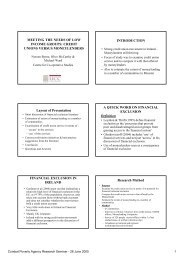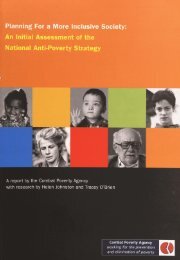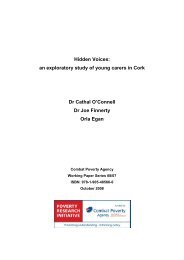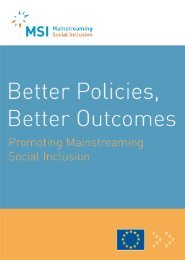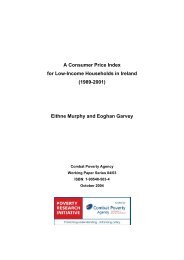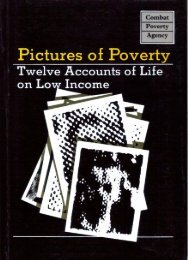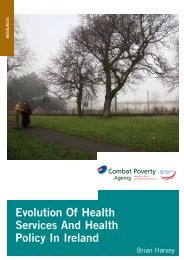The Distribution of Income in Ireland (2000) - Combat Poverty Agency
The Distribution of Income in Ireland (2000) - Combat Poverty Agency
The Distribution of Income in Ireland (2000) - Combat Poverty Agency
- No tags were found...
You also want an ePaper? Increase the reach of your titles
YUMPU automatically turns print PDFs into web optimized ePapers that Google loves.
18 <strong>The</strong> <strong>Distribution</strong> <strong>of</strong> <strong>Income</strong> <strong>in</strong> <strong>Ireland</strong>Figure 3.1: Decile Shares <strong>in</strong> Equivalised Disposable <strong>Income</strong>for Irish Households, 1994 and 1997 LII Surveys*3 4 5 6 7 8 9 10* See Table A2.1 <strong>in</strong> Appendix 2 for data.• LII 1994QUI 1997A comparison with Table 3.1 shows that equivalisation producesa more equal distribution <strong>in</strong> each year. <strong>The</strong> share <strong>of</strong> thetop decile is lower than before equivalisation, and the shares <strong>of</strong>the bottom two deciles are higher by what is, <strong>in</strong> proportion totheir unadjusted share, a very substantial amount.This reflects the fact that larger households have, on average,higher <strong>in</strong>comes than smaller households. Many <strong>of</strong> thehouseholds towards the bottom <strong>of</strong> the unadjusted distribution,for example, comprise s<strong>in</strong>gle (<strong>of</strong>ten elderly) adults or couples.Compar<strong>in</strong>g 1994 and 1997 we observe a similar pattern to thatshown <strong>in</strong> Table 3.1 for unadjusted <strong>in</strong>come. <strong>The</strong> bottom and top<strong>of</strong> the distribution lose share and deciles 5, 6, 7 and 8 all ga<strong>in</strong>,the net result be<strong>in</strong>g little change <strong>in</strong> overall <strong>in</strong>equality as reflected<strong>in</strong> the summary measures.Given the extent <strong>of</strong> uncerta<strong>in</strong>ty about the most appropriateway to adjust <strong>in</strong>come for such differences, we need to test howsensitive these results are to alternative equivalence scales.<strong>The</strong> other four sets <strong>of</strong> equivalence scales described <strong>in</strong> Chapter2 are now employed, to see whether the shape <strong>of</strong> the disposable<strong>in</strong>come distribution is affected by the choice <strong>of</strong> scale. Table3.3 shows decile shares among households <strong>in</strong> both the 1994and 1997 LII surveys with each <strong>of</strong> these scales. We see theequalis<strong>in</strong>g impact <strong>of</strong> equivalisation occurs with each <strong>of</strong> thescales, and the shape <strong>of</strong> the distribution is very similar across<strong>The</strong> <strong>Distribution</strong> <strong>of</strong> <strong>Income</strong> <strong>in</strong> the 1990s 19all five sets <strong>of</strong> scales. Compar<strong>in</strong>g 1994 and 1997, all the scalesshow once aga<strong>in</strong> the marked decl<strong>in</strong>e <strong>in</strong> share for the bottom <strong>of</strong>the distribution and the top decile which we saw <strong>in</strong> Table 3.3.While there are some differences across the scales <strong>in</strong> the exactpattern <strong>of</strong> change from 1994 to 1997, all show a substantial decl<strong>in</strong>e<strong>in</strong> share for the bottom half <strong>of</strong> the distribution and <strong>in</strong>creasefor the top half.Up to this po<strong>in</strong>t, we have been concerned with the distribution<strong>of</strong> <strong>in</strong>come among households. As discussed <strong>in</strong> Chapter 2, itmakes sense to treat each household as a s<strong>in</strong>gle unit and "counthouseholds" if no adjustment is made to <strong>in</strong>come for differences<strong>in</strong> household size. When equivalent <strong>in</strong>come is used, however,focus<strong>in</strong>g on persons seems more appropriate s<strong>in</strong>ce we are primarilyconcerned with the distribution <strong>of</strong> welfare or liv<strong>in</strong>g standardsamong persons rather than households. Much <strong>of</strong> the previousresearch on the Irish <strong>in</strong>come distribution refers to thedistribution among households, and it is only on this basis thatresults from the 1973 and 1980 Household Budget Surveys areavailable. However, it is <strong>of</strong> <strong>in</strong>terest to now also look at the distributionamong persons, which is achieved by weight<strong>in</strong>g eachhousehold <strong>in</strong> the analysis by the number <strong>of</strong> persons it conta<strong>in</strong>s.It must be emphasised that, as discussed <strong>in</strong> Chapter 2, the assumptionis still be<strong>in</strong>g made that resources are distributedwith<strong>in</strong> the household so that each member <strong>of</strong> a given householdhas the same liv<strong>in</strong>g standard: we are now <strong>in</strong> effect simplycount<strong>in</strong>g persons rather than households.




